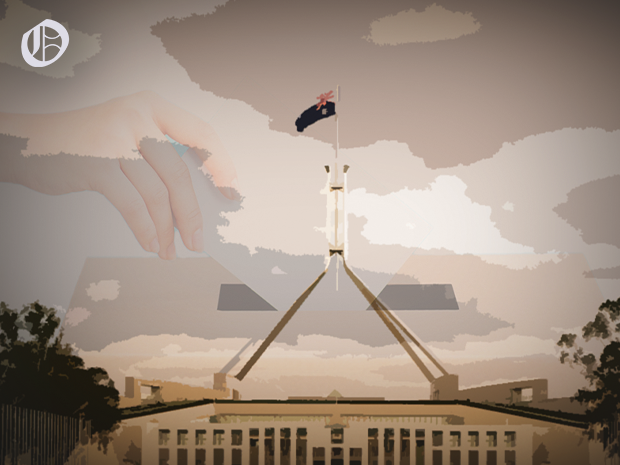“Threatens the Very University Itself”: NTEU-Chancelry Feud Deepens as Criticism Mounts on VC Bell

Written by: Finn Slattery-O’Brien
Additional Reporting: Angela Paulson
At 12 pm on October 16, ANU staff marched on Kambri Lawns to voice their frustrations with the executive body over impending lay-offs.
Organised by the National Tertiary Education Union (NTEU), the protest followed a series of announcements from the ANU Chancelry about their plans to massively rollback staff expenditure.
In what Vice-Chancellor Bell has dubbed ‘Renew ANU’, this planned program involves a complete reshuffle of the colleges and schools, including cutting the College of Medicine, almost tripling parking fees, and asking staff to forgo a 2.5 per cent pay rise this December. The ongoing debate over graduation ceremonies also highlights part of ANU’s wider financial troubles.
Some staff suggested this represents an attempt by the Vice-Chancellor to limit the impact of prior “financial mismanagement”, which blew out the ANU’s initial projected deficit from $60 million to over $200 million.

Speaking to the gathered protestors, NTEU Branch Director, Lachlan Clohesy (as pictured above), highlighted the magnitude of cuts the university would have to make in order to meet its current goal of wiping $150 million in staff expenditure.
“We estimated that [$150 million] to be 12.24 per cent of staff expenditure. That is equivalent to 638 full-time employed jobs.”
He also conceded that due to the relatively recent appointment of the Vice-Chancellor, there were “some inherited issues [for her] there.”
However, he did affirm that these issues were an overall governance problem, saying, “We’re looking at the previous Vice-Chancellor too” and that Bell’s recent record looked like she was trying to be the ‘‘[m]ost unpopular Vice-Chancellor in human history.”
Protesters also blamed Chancellor Julie Bishop, calling for her resignation.
Clohesy emphasised that although Bell was a recent addition, Bishop has been Chancellor (and thus Chair of the ANU Council) since 2020, and that “anyone else would be sacked” for overseeing the blown-out deficit forecast.
“[the executive leadership has] mismanaged this university to such an extent that it now threatens the very university itself,” says Clohesy.
The NTEU also called for Bishop’s sacking in the mainstream media, citing “disgraceful comments” where the Chancellor referred to staff that were (and are yet to be) laid-off as “inefficiencies” that the “university is now seeking to address.”
The protest was punctuated by the usual union cries of “solidarity” and “shame”.
However, there were also frequent, impassioned audience injections calling for all executives to resign, demonstrating the boil-over from the announced staff cuts and the acute anger of many ANU staff members.

Afterwards, the protestors marched to the Chancelry building with the express purpose of symbolically holding a vote on whether to accept or reject the Vice-Chancellor’s calls for them to forgo a pay rise.
This comes despite NTEU protests late last year negotiating for this very pay rise to be included in the staff enterprise agreement. The agreement includes a clause allowing staff to vote on potentially forgoing this pay rise.
According to the agreement, this is “[a]ny person employed by the University at any time when this Agreement is in operation, with the exclusion of those outlined below” (clause 2.1). Those excluded are:
- “any person employed under the Live Performance Award 2020, with the exception of employees engaged as simulated patients as defined in Schedule 3.4; and
- any person employed as a senior management appointment as defined in clause 10.”
It is unclear as to what will happen if staff vote to take the pay raise. Will the university cut even more jobs in order to meet the staff expenditure target?
ANU is not the only university facing job cuts, notably, the University of Canberra (UC) is also currently experiencing financial difficulties.
In what seems a not-so-subtle swipe at Bell, UC Vice-Chancellor Stephen Parker made clear that while “probably the majority” of savings would come from staff cuts, UC would not ask any staff to forgo a pay rise.
Bell had taken a pay cut of 10 per cent from her $1.15 million salary prior to the protest.
In comparison, her predecessor, Brian Schmidt, negotiated his salary down to $484,000 (from $560,000) after a $162 million deficit in 2021. Even with her self-imposed pay cut, Bell will still be earning over $1 million a year, more than twice Schmidt’s salary.
If ANU’s deficit increases past the predicted $200 million, it may well be the largest in the country’s tertiary education history, with a chance to eclipse the University of Melbourne’s $246 million in 2008.
More to come.
Photography by: Finn Slattery-O’Brien and Angela Paulson
Know something we don’t know? Email [email protected] or use our anonymous tip submission.
If you have an issue with this article, or a correction to make, you can contact us at [email protected], submit a formal dispute, or angry react the Facebook post.
Want to get involved? You can write articles, photograph, livestream or do web support. We’re also looking for someone to yell “extra!” outside Davey Lodge at 1AM. Apply today!









